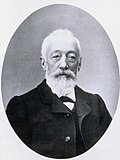Milk chocolate
Milk Chocolate is a popular type of chocolate that combines cocoa, milk, and sugar. It was first created in the 19th century and has since become a staple in many types of confectionery and desserts.
History[edit]
Milk chocolate was first created in 1875 by Daniel Peter, a Swiss confectioner who was trying to make a type of chocolate that was smoother and creamier than the dark chocolate that was common at the time. He achieved this by adding condensed milk, a product developed by his neighbour Henri Nestlé. This new type of chocolate quickly became popular, and is now one of the most commonly consumed types of chocolate worldwide.
Production[edit]
The production of milk chocolate involves several steps. First, the cocoa beans are harvested and fermented. They are then dried and roasted to bring out the chocolate flavour. The roasted beans are ground into a paste known as chocolate liquor, which is then combined with milk and sugar to create milk chocolate. The chocolate is then tempered, or slowly heated and cooled, to give it a smooth and shiny finish.
Varieties[edit]
There are many different varieties of milk chocolate, which can vary based on the amount of cocoa, milk, and sugar used. Some popular varieties include Swiss chocolate, which is known for its smooth texture and high milk content, and Belgian chocolate, which is often made with a higher percentage of cocoa. There are also many types of flavoured milk chocolate, such as mint chocolate or orange chocolate, which include additional ingredients for flavour.
Health Effects[edit]
While milk chocolate is often enjoyed for its taste, it is also high in sugar and fat, which can contribute to health issues such as obesity and heart disease if consumed in excess. However, it also contains some beneficial nutrients, such as calcium from the milk and antioxidants from the cocoa.
See Also[edit]
-
Milka Alpine Milk Chocolate bar 100g with chunks broken off
-
Daniel Peter
-
Gala Peter
-
A suchard on nov 2020
-
Hershey bar open
-
Toblerone Split
-
Cadbury Buttons
-
Schokolade braun
Ad. Transform your life with W8MD's Budget GLP-1 injections from $75


W8MD offers a medical weight loss program to lose weight in Philadelphia. Our physician-supervised medical weight loss provides:
- Weight loss injections in NYC (generic and brand names):
- Zepbound / Mounjaro, Wegovy / Ozempic, Saxenda
- Most insurances accepted or discounted self-pay rates. We will obtain insurance prior authorizations if needed.
- Generic GLP1 weight loss injections from $75 for the starting dose.
- Also offer prescription weight loss medications including Phentermine, Qsymia, Diethylpropion, Contrave etc.
NYC weight loss doctor appointmentsNYC weight loss doctor appointments
Start your NYC weight loss journey today at our NYC medical weight loss and Philadelphia medical weight loss clinics.
- Call 718-946-5500 to lose weight in NYC or for medical weight loss in Philadelphia 215-676-2334.
- Tags:NYC medical weight loss, Philadelphia lose weight Zepbound NYC, Budget GLP1 weight loss injections, Wegovy Philadelphia, Wegovy NYC, Philadelphia medical weight loss, Brookly weight loss and Wegovy NYC
|
WikiMD's Wellness Encyclopedia |
| Let Food Be Thy Medicine Medicine Thy Food - Hippocrates |
Medical Disclaimer: WikiMD is not a substitute for professional medical advice. The information on WikiMD is provided as an information resource only, may be incorrect, outdated or misleading, and is not to be used or relied on for any diagnostic or treatment purposes. Please consult your health care provider before making any healthcare decisions or for guidance about a specific medical condition. WikiMD expressly disclaims responsibility, and shall have no liability, for any damages, loss, injury, or liability whatsoever suffered as a result of your reliance on the information contained in this site. By visiting this site you agree to the foregoing terms and conditions, which may from time to time be changed or supplemented by WikiMD. If you do not agree to the foregoing terms and conditions, you should not enter or use this site. See full disclaimer.
Credits:Most images are courtesy of Wikimedia commons, and templates, categories Wikipedia, licensed under CC BY SA or similar.
Translate this page: - East Asian
中文,
日本,
한국어,
South Asian
हिन्दी,
தமிழ்,
తెలుగు,
Urdu,
ಕನ್ನಡ,
Southeast Asian
Indonesian,
Vietnamese,
Thai,
မြန်မာဘာသာ,
বাংলা
European
español,
Deutsch,
français,
Greek,
português do Brasil,
polski,
română,
русский,
Nederlands,
norsk,
svenska,
suomi,
Italian
Middle Eastern & African
عربى,
Turkish,
Persian,
Hebrew,
Afrikaans,
isiZulu,
Kiswahili,
Other
Bulgarian,
Hungarian,
Czech,
Swedish,
മലയാളം,
मराठी,
ਪੰਜਾਬੀ,
ગુજરાતી,
Portuguese,
Ukrainian







